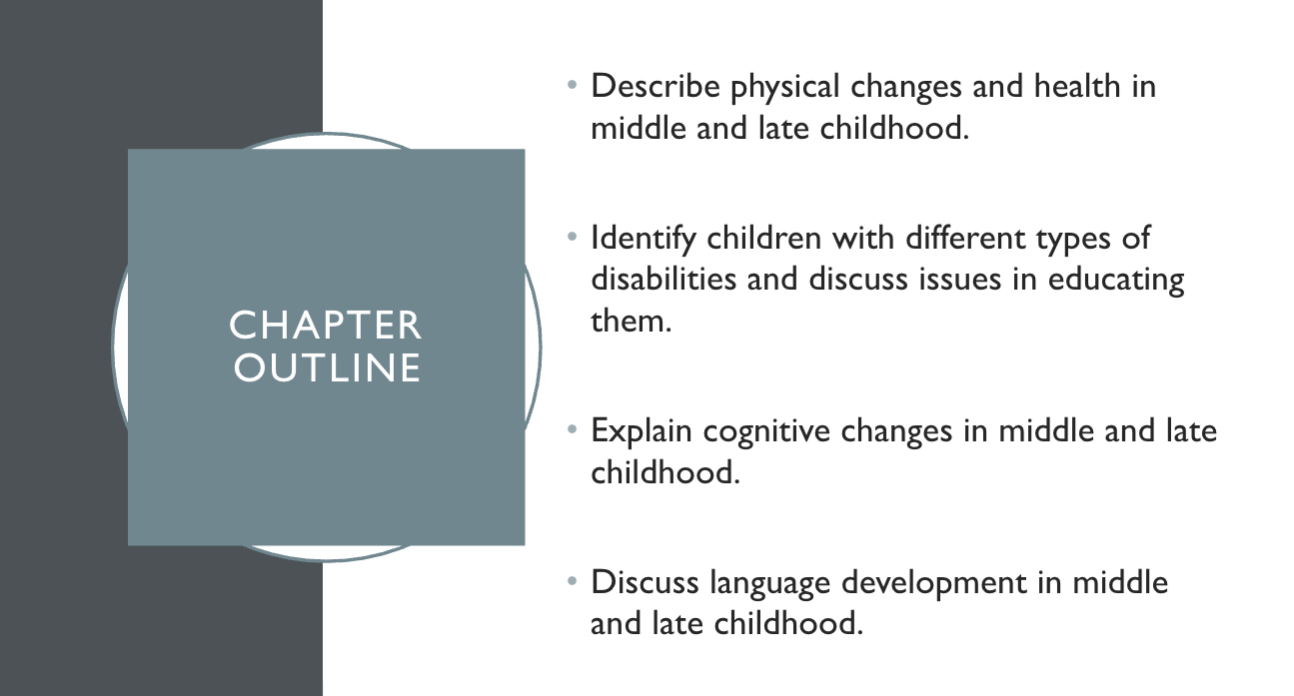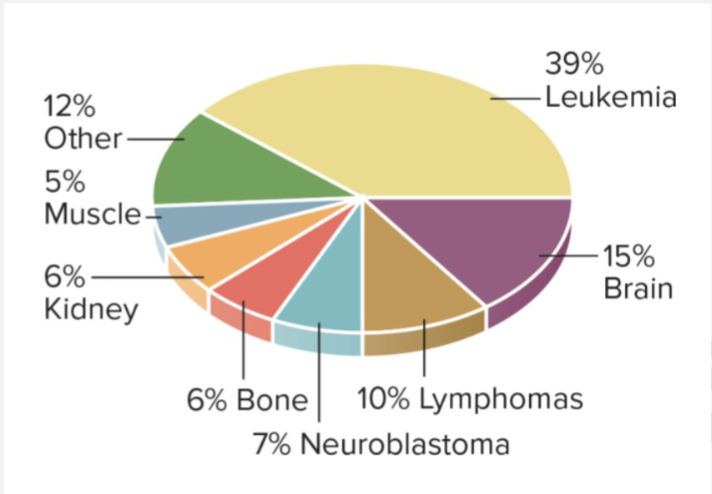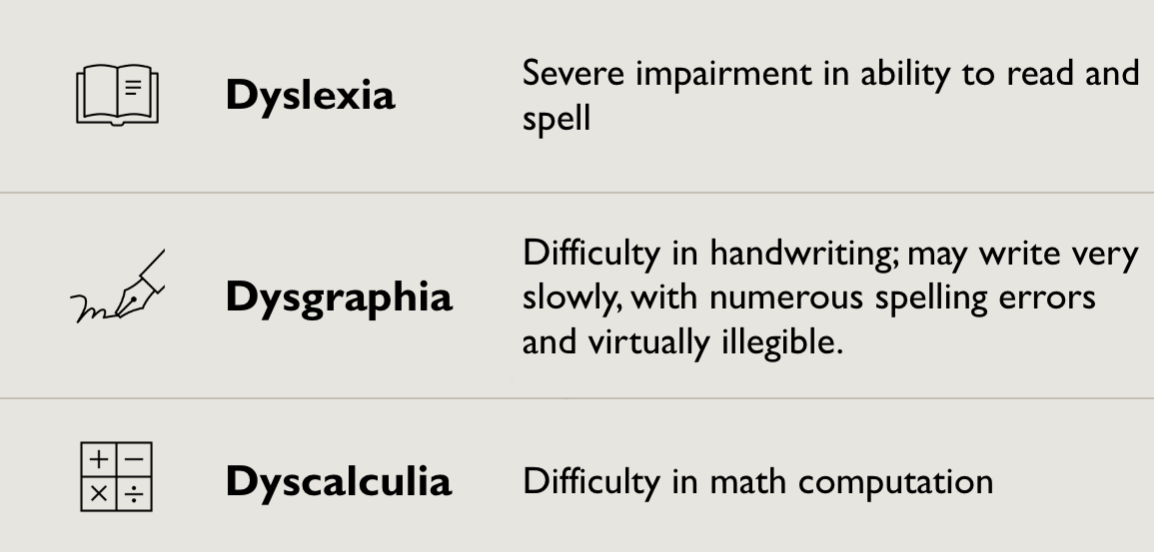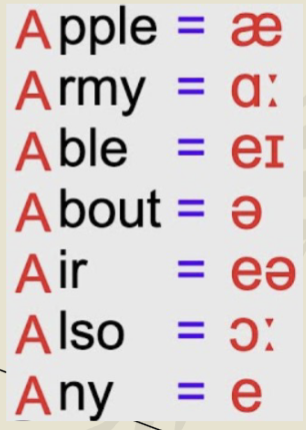Chapter 9
Physical & Cognitive Development in Middle and Late Childhood

Child Growth
Height and weight: During elementary school years…
Children grow an average of 2-3 inches a year
Average girl is 4’10” and the average boy is 4’9” - at the age of 11
Gain about 5-7 pounds a year
Mainly due to growth of the skeletal and muscular systems, as well as some body organs
The brain
Total brain volume stabilizes by the end of late childhood
Significant changes in specific structures and/or regions of the brain continue to occur
Advances in the prefrontal cortex ar linked to children’s improved attention, reasoning, and cognitive control
Motor Development
Children’s motor skills become smoother and more coordinated
Elementary school children can master many physical skills: climbing, skipping rope, swimming, bicycle riding, and skating.
Fine motor skills:
By 6 - children can hammer, cut hammer, cut and paste, tie shoes, and fasten clothes
By 7 - children’s hands are steadier; they prefer pencils over crayons for printing
By 8-10 - children can write rather than print words
By 11-12 - children can master complex, intricate, and rapid movements; playing an instrument
Health
For the most part, middle and late childhood is a time of excellent health
Accidents and injuries
Injuries ar the leading cause of death in middle and late childhood
Motor Vehicle accidents are the most common cause of severe injury
Child booster seats reduce risk for serious injuries by 45% in ages 4-8
Overwight children
Causes - heredity and environmental context
Consequences - diabetes, hypertension, and elevated blood and/or cholesterol levels
Intervantions - emphasize the importance of parental involvement and engagement in healthier lifestyles themselves
Illness and Disease
Cancer is the second leading cause of death in children 5 to 14 years of age
One in every 330 children in the US develops cancer before the age of 19
The most common cancer in children is Leukemia, followed by brain cancer

Disabilities
In the US 14% from 3 to 21 year of age received special education or related services
The percentage of students receiving special education is higher for males than females

Learning DIsabilities
A child with learning disability has difficulty in learning that involves understanding or using spoken or written language
The difficulty can appear in listening, thinking, reading, writing, and spelling (or mathematics).
To be classified as a learning disability, the learning problem must NOT be primarily the result of…
Visual, hearing, or motor disabilities
Intellectual. disabilities or emotional disorders
Environmental, cultural, or economic disadvantage

ADHD
Attention Deficit Hyperactivity Disorder (ADHD) is a disability in which children consistently show one or more of the following characteristics over a period of time:
1) Inattention - have difficulty focusing in any one thing; get bored with task after only a few minutes or even seconds
2) Hyperactivity - show high signs of physical activity, seeming to be almost constantly in motion
3) Impulsivity - have difficulty curbing their reactions; find ithard to think before they act.
Possible causes:
Genetics
Brain damage during prenatal or postnatal development
Cigarette and alcohol exposure during development
Low birth weight
Autism
Autism Spectrum Disorders (ASD) are characterized by difficulties with social interaction, problems in verbal and nonverbal communication, and repetitive behaviors.
Children may also show atypical responses to sensory experiences
Early signs for ASD:
Lack of social gestures at 12 months
Using no meaningful words at 18 months
Having no interest in other children and no spontaneous two-word utterances at 24 months
Piaget’s Concrete Operational Stage
The concrete operational stage is the thirds stage, and it takes place during the ages of 7 to 11 years
At this stage, children develop an understanding of:
Conservation: the idea that objects quantity does not change even if its appearance does
Reversibility: The idea that some things can be returned to their original state after being changed
Classification: the ability to categorize objects based on similarities, shape, or color.
Seriation: ability to order stimuli along a quantitative dimension
Transitivity: ability to logically combine relations to understand certain conclusions
Memory
Short-term memory is a passive storehouse that stores information until it is moved to long-term memory, or it is discarder.
Increases during early childhood but not much more after the age of 7
Long-term memory is a relatively permanent and unlimited type of memory.
Increases with age during middle and late childhood.
Improved in memory reflect children’s increased knowledge and their increased use of strategies
Not just considering the amount of information, but rather how it is retained and retrieved for a later use
Knowledge and Expertise
Much of the research on the role of knowledge in memory has compared experts and novices
Experts have acquired extensive knowledge about a particular content area
This influences what they notice and how they organize, represent, and interpret information.
One Study Found
10- annd 11-year-olds who were experienced chess players (experts) were able to remember more information about the location of chess pieces on a board that college students who were not chess players (novices).
However, when presented with other stimuli, the college students remembered them better than the children
Thus, the children’s expertise in chess gave them superior memories, but only in chess-related stimuli
Strategies
The following are effective strategies that adults can share with children to help them improve their information processing skills.
Advise children to elaborate on what is to be remembered
Elaboration involves engaging in more extensive processing of information
Encourage children to engage in mental imagery
Mental imagery helps to remember pictures, but also to solidify concepts encoded as verbal information
Motivate children to remember material by understanding it rather than by memorizing it.
Understand it, give it meaning, elaborate it, and personalize it so it’s easier to retrieve.
Language Development
Children learn new skills as they enter school that make it possible for them to learn to read and write
There skills include:
Increased use of language to talk about things that are not physically present
Leaning what a word is
Learning how to recognize and talk about sounds
Evidence of Language Development
Changes occur in the way children’s mental vocabulary is organized
When asked to say the first thing that comes to mind when they hear a word…
Preschool children typically provide a words that often follows the word in a sentence
After 7, children begin to respond with a word that is the same part of speech as the stimulus word.
Example: “dog”
Young children are likely to respond with '“bark”
Older children are likely to respsond with “cat”
Reading
Vocabulary development plays an important role in reading comprehension
Children who begin elementary school with a robust vocabulary have an advantage in learning to read
The phonics approach emphasizes that reading instruction should teach basic rules for translating written symbols into sounds
In English, the letter “A” can make up to 9 different sounds
Teaching children that “A” is for “Apple” can be confusing as they begin to read

Writing
As they ebgin to write, children often invent spellings
Parents and teachers should encourage childrne’s early writing but not be overly concerned about the formation of letters and spelling.
Correction should be selective and mad ein a positive way
Becoming a good writer, much like becoming a good reader, takes many years and lots of practice